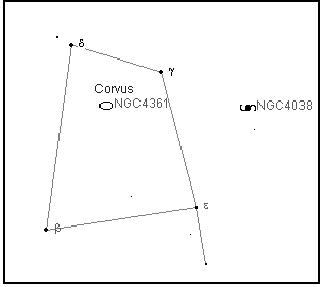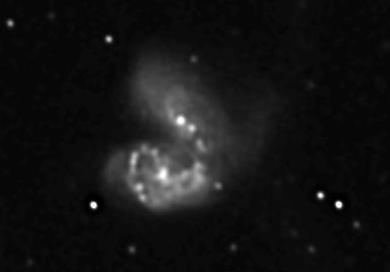NGC 4038: The "Ringtail Galaxy"
Jack Kramer
Deep sky objects often have more than one nickname and/or catalog designation; the galaxy NGC 4038 in the constellation Corvus is one such example. It's known both as the "Ringtail Galaxy" and as the "Antennae". Whatever you call it, this is one of the more interesting deep sky objects. At magnitude 10.7, it's easily visible on spring nights from a dark site. To locate it, draw an imaginary line from the star ä (Delta) to ã (Gamma), then about an equal distance further to the general field of NGC 4038.

This is not really a single galaxy, but an interacting pair (believed to be spirals) whose "Antennae" name refers to twin filaments of gas drawn out by tidal forces. Its more complete designation is NGC 4038/9, and it's also in the catalog of peculiar galaxies as Arp 244. New radio observations of the colliding galaxies suggest that they contain far more molecular gas -- the raw material of star formation -- than previously recognized. Using radio telescopes, University of Illinois astronomers have mapped carbon monoxide emissions from the pair. By making sensitive wide-field and high-resolution maps, they picked up signals that had been overlooked in earlier studies that only detected a handful of dense molecular clouds. They predict that NGC 4038/9 will undergo what's called an "ultraluminous starburst" about 100 million years from now, when the ongoing collision compresses the galaxies' reservoir of molecular gas to form billions of new stars in a spectacular galactic eruption. So in the far distant future this galaxy may become one of the most luminous objects in the heavens.
Another feature of this pair of galaxies is a number of globular clusters that appear especially bright in the blue end of the spectrum. This indicates they are unusually young for globulars and has led some astronomers to conclude that they were formed as a result of the interaction of the two galaxies.
As with any such object, the larger your telescope, the more you'll see. In my 10-inch, the hubs of the two galaxies stand out as separate nodes, with the arms fading off and becoming gradually indistinct. The system shows faint structure along both the major and minor axes. The following CCD image by Michael Purcell gives some indication of the complex structure of this system. Note the nodules of bright matter scattered throughout the disks of the galaxies. Catalogs show the fainter of the two galaxies, NGC 4039, as about magnitude 13; however, I found it quite easy to see, no doubt due to its proximity to NGC 4038.
After locating a galaxy such as this, it becomes an interesting mental exercise to consider the implications of what's going on out there. In the emptiness of space, two galaxies happen to have encountered one another, so near that they are tearing each other apart. They may actually be colliding. Too bad we won't be around in 100 million years to watch them erupt in spectacular fashion!






